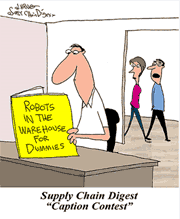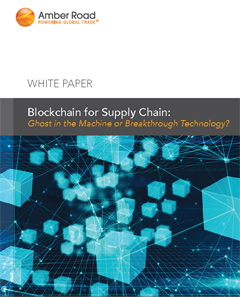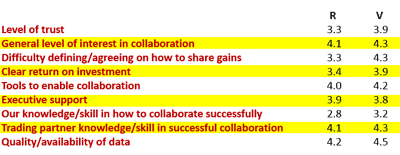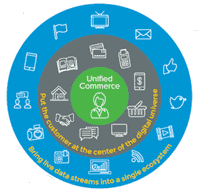Can Supply Chain Collaboration Save Retailers and Manufacturers?
Desperate times call for desperate measures.
That is the axiom I keep coming back to as I survey the consumer goods to retail supply chain, which I do with some regularity.
The retail world is obviously transforming dramatically before our eyes. Last year, there were some 6500 net stores closings in the US. Projections are for similar numbers this year.
| GILMORE SAYS: |
In such perilous times, the tendency is to focus inward, not look at how true collaboration might allow some to survive and even prosper.
WHAT DO YOU SAY?
Send us your
Feedback here
|
In 2018 we have seen the outright failure of the Toys R Us chain and now the Bon-Ton chain of several department store banners, including Bon-Ton, Elder-Beerman, Younkers, Carson Pirie and others.
What is seismic about the Bon-Ton failure is that it is placing still more pressure on mall owners, many of which had large Bon-Ton anchor stores.
Malls are in deep trouble. The largest mall in the US when it opened in the 1970s, the Randall Park Mall east of Cleveland shuttered finally in 2015. But the land got new life in 2017 when it was announced the space would house - what else - a new 850,000 square foot Amazon fulfillment center.
Macy's recently closed it downtown Cincinnati store - just a few blocks from its headquarters. That one still has me shaking my head.
What most frightens me is that all this is happening in good economic times. What the carnage is going to look like when the next recession finally hits I hate to ponder.
As I have noted before, things are tough for many consumer goods companies as well. The Toys R Us closing is hammering many toy makers. But perhaps most interesting is the challenges of traditional consumer packaged goods products, where changing consumer habits and other factors are putting great pressure on companies from Campbell's Soup to Kellogg, anyone whose products occupy the "center aisle."
And CPG companies are getting hammered by other market forces. Giant Procter & Gamble said prices for its products fell by 2% for the first three months of 2018. That at the same time transportation and most other input costs are rising steadily. Not a pretty picture for the bottom line.
Obviously, there is a lot going on here, most notably ecommerce but of course that doesn't tell the whole story by any means. Consumer shopping habits more generally are undergoing rapid change: more emphasis on fresh rather than packaged foods; less interest in spending time inside a mall on a Saturday afternoon; a sharp decline in the percent of disposable income spent on apparel (from 6% four decades ago to 3% currently - and falling).
There was an article just this week that ecommerce was destroying neighborhoods. CNBC reported that the decimation of retail "has brought a deterioration in places where people congregated, socialized, made friends and were greeted by a friendly face offering an intangible element of belonging to a community."
Of course, there was a similar and equally great change in many downtowns now two or more decades ago as Walmarts moved in and put all the local merchants in small downtowns out of business.
So here we are. How the world will look coming out of all this change I have no idea.
But I do know that for about three decades now there have been calls for greater levels of supply chain collaboration between retailers and manufacturers.
If you look back at all the retail related supply chain initiatives for three decades (Quick Response; Efficient Response; Collaborative Planning, Forecasting and Replenishment; EPC RFID; etc.), the problems and opportunities described for each new initiative are nearly identical - and are all focused around better information sharing.
Yet here we are. The sector has obviously has made some progress, but just incremental, really, from my view. Just a few years back, the VICS organization (later absorbed by GS1) issued a guideline around "building the supply chain from the shelf back." (There is an interesting back story on this that I may share some time.)
But the point of the guideline was the that the famous Bullwhip Effect was still alive and well in the consumer goods to retail sector - and that it could be significantly tamed if retailers and vendors worked together to drive the supply chain from actual consumer demand, all the way back to the factory schedule.
I agreed then, and I agree now. But as far as I can tell, that VICS initiative has gone almost nowhere, with no on-going effort to drive such changes.
Well, maybe these desperate times for retailers and manufacturers could be enough to at last change the status quo. Walmart, Target, and other chains have launched programs and new chargebacks to reduce vendor variability, mostly around fill rates and on-time shipments. I applaud that generally, but these programs have a top-down, compliance feel, not a collaborative one.
Poor fill rates and late shipments are sometimes the result of vendor planning and execution issues. But far more often, they are the result of poor visibility to demand and order plans by the retailer. This of course is the essence of the Bullwhip Effect.
The reality is that in general retailers have not embraced the time-phased inventory and order planning in the way manufacturers have for decades. Interestingly, at a meeting of retailers and vendors a few years back, a few retailers which had started to share more of this info were griping that they weren't getting back from vendors for the effort - mostly meaning lower prices. But of course, improved fill rates and on-time shipments have their own rewards.
In our recent benchmark study on the state of retail-vendor supply chain relationships, we asked both retailers and vendors to rate the barriers to better collaboration.
As seen in the chart below, the top rated barrier for both retailers and vendors/manufacturers is a lack of quality/availability of data to act upon to collaborate (scale of 1 to 7, with 7 being the highest barrier - score is the average among respondents).This lack of actionable information is of course the essence of the initiatives around ECR, CPFR, RFID, etc. But not much really changes. |



![]()

![]()

![]()












